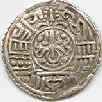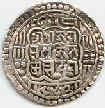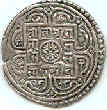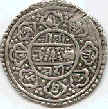
Nepales Coins for circulation in
Tibet.
History.
While standard weights and measures were introduced into Tibet from India in the
ninth century, it was not until the seventeenth century that coined money became
the accepted medium of exchange. These coins, called thangkas, were in the
beginning minted in Nepal for use in Tibet. While these thangkas formed
the currency of Tibet, they were not in fact Tibetan coins.
Patan
minted thangkas for use in Tibet in the years 1631-1771, Bhatgaon in the years
1663-1722 and Kathmandu in the years 1641-1776. The above mentioned coins are
dated according to the Newar Era of Nepal and bear dates ranging from 751 N.E.
(1631 AD) to 896 N.E. (1776 AD).
In addition to the coins of Nepal, also the silver coins of China and India
received wide acceptance in Tibet. The silver rupee of India for example,
an exact multiple of the thangka, circulated throughout the southern parts of
Tibet, passing forwards and backwards in trade between India and Tibet.
It was
in 1773, after Prithvi Narayan laid siege to the Kathmandu valley, and cut all
trade between Nepal and Tibet, that the Tibetan authorities began to strike
their own coins.
Some examples of Nepalese coins stuck for Tibet.
 


Kingdom of
Bhatgaon
KM 108 ; Nan
Tang or Black
Thangka.
Year NS842 (1722
AD)
Billion; poor silver
 


Shah Dynasty
KM 472.2 ; used for clipped or cutted coins
Year SE 1698 (1776 AD)
Billion; poor silver
Clipped or cutted coin.
The silver Mohar KM472.2, was struck in large quantities and sent to Tibet,
where it was often cut or clipped for use as small change. The full coin
circulated at the value of 1.5 Sho. If this coin was cut into fractions of 2/3,
1/2 or 1/3 the value of the cutted coin was 1, 0.75 and 0.5 Sho.
 
Cutted coins
Two methods of
cutting were use, the earliest method merely used a straight line cut, whereas
during the early 19th century it became normal to cut much of the center out of
the fractions. The denomation was determined by the number of petals visible.
The cutted coins continued to circulate until the 1920's.

|  Hans Sanders (NL)
Hans Sanders (NL)